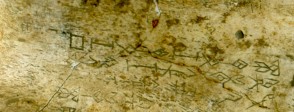Start by asking the students what they think the object is and what they can recognise about it. Use the Story section of the British Museum Ancient China website to explain what it is and how it was used – see For the classroom.
Discuss who used such bones and what sorts of questions were asked. Why do the students think these were important matters to try to find out about? If they were ancient rulers, are there other things they might like to ask about? Find out about some famous oracles in ancient Greece and compare them with the oracle bone questions.
What does the use of the bones tell us about ancient Chinese beliefs about the afterlife? Do Chinese people still believe in fortune telling, 3500 years later? What methods do they use today and are there similarities with methods used in other cultures including our own? Think about whether the results of these methods could be manipulated by the fortune-teller? What does this mean for both the fortune-teller and the person wanting the answers, especially if he or she is the fortune-teller’s ruler?
The following suggestions aim to encourage broader historical enquiry.
Who could read and write in ancient civilisations?Explore how the use of writing developed in China and find out about its use in religion, the importance of scribes and the growth of the civil service. Compare this with other civilisations such as Mesopotamia and Egypt – these resources include Object Files on both civilisations.
Over the centuries, through trade and military contacts, the Chinese character system spread to other countries in Asia, principally Japan, Korea and Vietnam. Find out how and when these contacts were made. What does the adoption of a foreign script indicate about a country’s relationship with the country from where the script comes? You might compare this with the use of Latin and its script in the Roman empire.
These three activities explore the way symbol-based languages work and can be done either in sequence or individually.
Use the Challenge section of the British Museum Ancient China website to play a game exploring how pictures are transformed into symbols or characters – see For the classroom.
Show the students the oracle bone inscription about hunting in For the classroom. Ask the students whether they can see any recurring symbols and any symbols that may look like something. Tell them that the text is about hunting and ask again if they think any of the symbols may refer to a picture of something. Do they consider this to be picture writing? Compare it with any list of Egyptian hieroglyphic characters. Ask the students if they can see any similarities in the way characters have been formed.
Ask the students to translate into picture writing a simple sentence using only concrete nouns, for example: the girl runs to the mountain. Discuss how easy or difficult this was and whether their picture writing could give a different meaning from the one they intended.
Introduce a new sentence to the students with abstract ideas and emotions such as like, hate, love, angry, excited, and ask the students to translate them in the same way. Ask the same questions and discuss the differences. How did the students approach this task? Did any of them combine several words into one pictogram? If so, discuss why they did this.
The students may guess that they refer to words and then you could introduce that they may refer to parts of words, sounds or syllables. Together try creating words using combinations of pictograms to represent the sounds – start with the common rebus of an eye plus a deer for idea.
Students could use a modelling material to make their own oracle bones with the hollows on the reverse and either copies of real oracle bone script characters or their own invented pictograms on the front.


